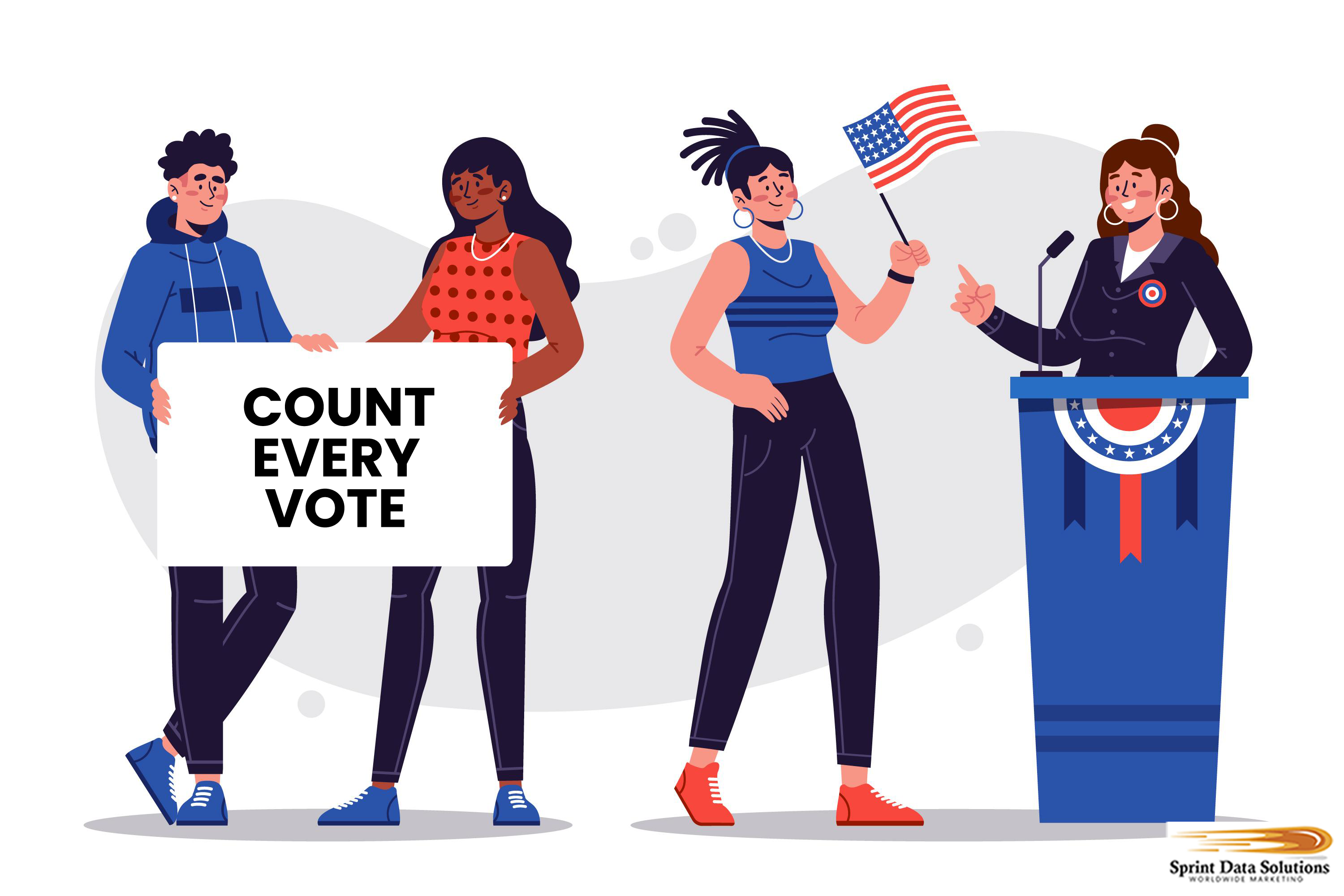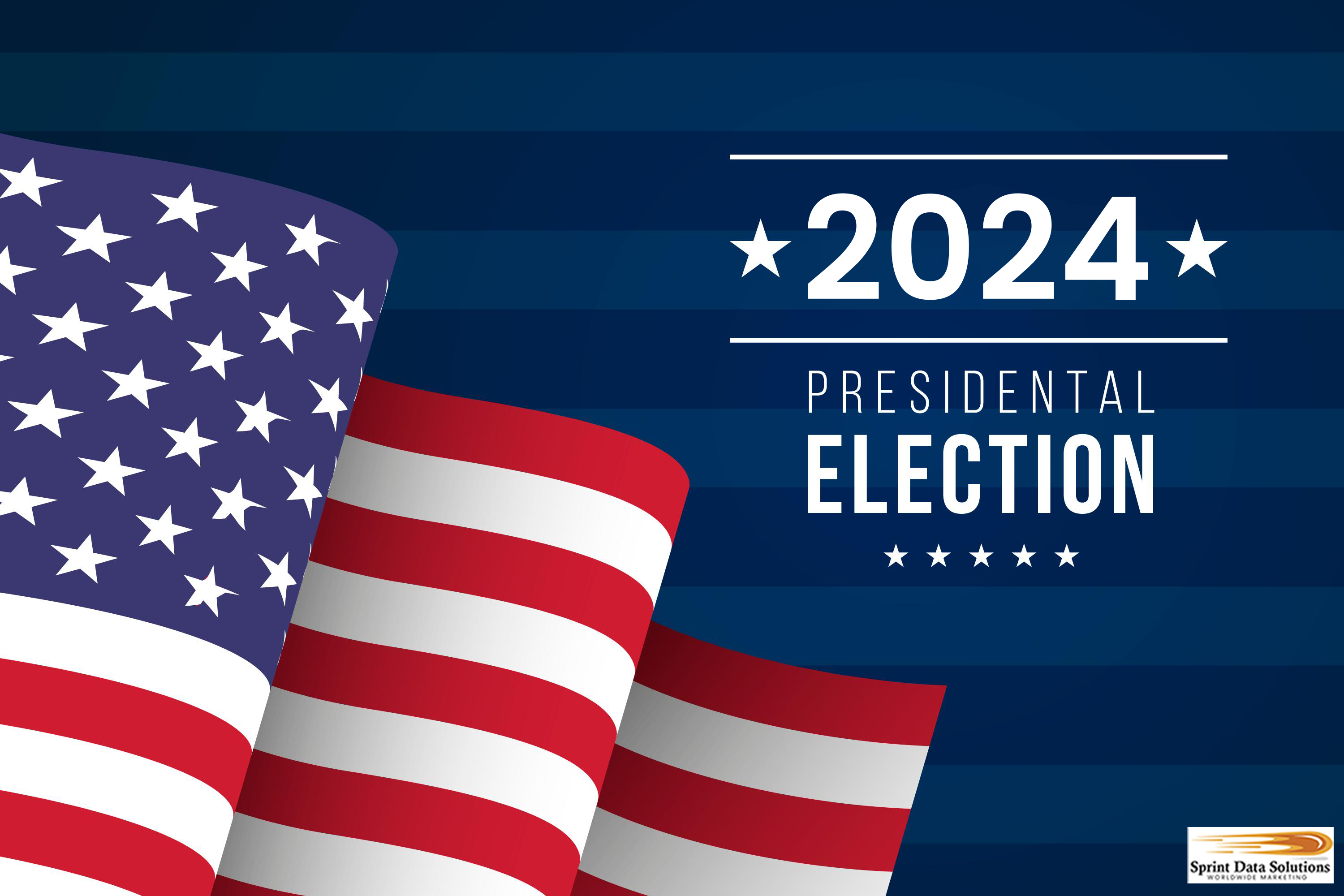Registered Voter Mailing List
The United States is one of the few countries in the world where citizens have had the privilege and responsibility of choosing their leaders through a democratic process since its founding. In this system, the power to select elected representatives rests with the people, allowing them to decide who will represent their interests at various levels of government. From the local to the state level, and all the way up to the federal level, Americans have a voice in shaping the leadership that will guide their communities, states, and country. This widespread participation is a fundamental feature of the U.S. democracy, distinguishing it from many other nations where the decision of leadership may be made by elites or through non-democratic means.
Central to this democratic system is the election process, a pivotal moment in American political life. Every election, whether local, state, or national, is a well-orchestrated campaign to engage voters, present candidates, and ultimately determine who will govern. Candidates, often after months or even years of campaigning, present their visions for the future, making their case to the public about why they are the best choice to represent them. From televised debates to rallies, town hall meetings, and digital outreach, campaigns use a variety of strategies to connect with voters, address their concerns, and offer solutions to the issues that matter most.
The election itself is a carefully structured event, where citizens cast their votes to decide the outcome. Historically, this process required people to travel to a polling station during a specific time window on election day. However, in response to evolving societal needs, the United States has made significant strides in making the voting process more inclusive. The introduction of mail-in voting has been a revolutionary development, allowing individuals to vote by mailing their ballots without needing to physically go to a polling place. This change has greatly expanded access to voting, enabling those with mobility challenges, people who work long hours, and others who may face barriers to voting during the designated hours to still participate fully in the democratic process. The flexibility of mail-in voting has been especially crucial in recent elections, ensuring that every eligible voter has the opportunity to have their voice heard.
While presidential elections are held every four years, the U.S. is never truly “between elections.” Local, county, and state elections are continuously ongoing, ensuring that there are always political campaigns in motion. As the country gears up for the next presidential election, the campaign machines of the two dominant political parties are already mobilizing, along with a growing number of independent candidates who aim to bring fresh perspectives to the table. The work leading up to a national election is often months or even years in the making, with political organizations working tirelessly to rally support, recruit volunteers, and raise funds to power their efforts.
For many years, Sprint Data Solutions Worldwide Marketing has played a vital role in supporting political organizations by helping them navigate the complexities of the electoral process. With its expertise in data management, analytics, and targeted outreach, Sprint Data Solutions Worldwide Marketing has provided critical tools to political campaigns, enabling them to connect with voters, understand their needs, and craft messages that resonate with diverse populations. As the country once again prepares for another election, Sprint Data Solutions Worldwide Marketing stands ready to assist in maintaining the integrity and effectiveness of the democratic process. With years of experience and a deep understanding of the political landscape, the company continues to help political organizations reach the right audiences, gather critical data, and optimize their efforts to ensure that every citizen’s vote counts in the ongoing work of democracy.
About Sprint Data Solutions Worldwide Marketing
Sprint Data Solutions Worldwide Marketing was founded by a disabled veteran with a vision to build a 100% American-based company that would contribute to the country’s economic growth by helping businesses expand their most valuable resource: their customer base. After completing years of service in the military, where sacrifices were made to protect the nation, the founder decided to pivot away from defense-related efforts and focus on fostering economic prosperity. The mission was clear: to help businesses across the nation grow by improving their ability to connect with customers and, in turn, boost their revenues.
Choosing Las Vegas, Nevada as the foundation for the company, Sprint Data Solutions Worldwide Marketing began as a small, local business. It wasn’t long before their commitment to quality service and results began to pay off, driving steady growth. The company quickly gained a reputation for its effective direct mail marketing services. Sprint Data Solutions Worldwide Marketing focused on gathering precise customer data, including names, mailing addresses, and detailed demographic information, and used these resources to help clients create highly targeted marketing campaigns. This precision-driven approach led to substantial success, establishing a strong client base that valued the company’s expertise in delivering measurable results.
As the business grew, so did its scope. Sprint Data Solutions Worldwide Marketing expanded from its original base in Las Vegas to serve clients across the entire continental United States, including Alaska and Hawaii. This nationwide reach allowed them to support businesses of all sizes, from local shops to large corporations. But the company didn’t stop there. Recognizing the growing demand for global marketing solutions, Sprint Data Solutions Worldwide Marketing broadened its services to include North American markets such as Canada and Mexico. The expansion continued, eventually reaching European markets like France, allowing clients to extend their marketing efforts internationally.
What started as a small operation with a single focus—direct mail marketing—has now evolved into a global powerhouse. Sprint Data Solutions Worldwide Marketing has not only expanded its geographic reach but also diversified its service offerings, embracing digital marketing to complement its traditional strengths. The company is now a full-service marketing provider with over 50 years of combined industry experience among its dedicated staff. Whether serving small businesses or multinational corporations, Sprint Data Solutions Worldwide Marketing remains committed to its founding principles of quality service, customer satisfaction, and driving business growth through innovative marketing strategies. Today, the company is proud to provide tailored marketing solutions on a global scale, empowering businesses to connect with their target audience like never before.

Elections Are Different In The New Millennium
The democratic process, particularly the ways in which voters are courted, has undergone a profound transformation over time, driven largely by the evolution of technology and the rise of the Internet. This digital revolution has fundamentally altered how campaigns are conducted, reshaping voter outreach strategies and prompting a reevaluation of traditional communication channels. Despite these changes, the core objectives of a political campaign have remained consistent: candidates must persuade voters that they are the right choice for the position, prove their credibility, and inspire trust in their ability to lead.
At the heart of any political campaign is the candidate’s ability to establish legitimacy. This is achieved through a combination of showcasing personal character, professionalism, and competence, all of which demonstrate their readiness to govern. Furthermore, candidates must articulate a clear and compelling platform, emphasizing the policies they will advocate for if elected. Promises of change and the vision for a better future are central to these campaigns, as voters are ultimately swayed by the potential for tangible improvements in their lives, communities, and country. In addition, a candidate must offer detailed plans for achieving these promises, ensuring voters can believe in their capacity to follow through.
The methods used to achieve these objectives, however, have evolved dramatically throughout history. In the early days of democracy, when technology was limited, campaigns were primarily based on direct interaction with voters. Candidates would visit various towns and neighborhoods, delivering speeches and engaging with constituents in person. This direct form of campaigning allowed candidates to form personal connections with voters, but its reach was constrained by geographical boundaries. In the absence of mass communication tools, candidates also relied on printed materials, such as posters, pamphlets, and flyers, to disseminate information and make their platforms known to a broader audience. These materials were simple yet effective in providing voters with key messages, though their impact was still limited by the technological constraints of the era.
The advent of radio marked the first significant shift in how political campaigns communicated with voters. By the early 20th century, radio broadcasting allowed candidates to reach large audiences without the need for face-to-face interactions. This new medium brought speeches, interviews, and policy discussions into homes across the nation, making it possible for candidates to speak directly to voters on a scale previously unimaginable. While in-person campaigning and print materials remained important, radio allowed for more frequent and far-reaching engagement, especially during national elections. Candidates could now be heard by millions of people simultaneously, amplifying their message and extending their influence.
Television took this transformation to another level, ushering in an era where visual representation became as crucial as verbal communication. The medium’s power to convey not only the words but also the demeanor, tone, and appearance of candidates revolutionized political campaigning. In addition to speeches and interviews, political advertisements on TV became a central component of modern campaigns, allowing candidates to reach voters in an entirely new way. These commercials often focused on emotional appeals, portraying candidates as relatable figures while highlighting their achievements or attacking opponents. Televised debates, once a novelty, became a critical part of the election process, offering voters a chance to witness candidates in direct confrontation, answering questions and addressing issues in real-time.
As technology continued to advance, the Internet and social media platforms emerged as game-changers in political campaigning. Today, digital platforms like Facebook, Twitter, and Instagram allow candidates to communicate with voters instantaneously and on a personal level. Social media enables candidates to target specific demographics with precision, crafting tailored messages that resonate with voters based on their interests, concerns, and values. The ability to run data-driven campaigns, leveraging analytics and voter behavior insights, has further transformed the landscape of modern politics. Additionally, online fundraising has revolutionized campaign financing, enabling candidates to raise money from a vast network of small-dollar donors rather than relying solely on large contributions.
The use of the Internet also introduced new forms of voter engagement, including interactive websites, email newsletters, and online town halls. Campaigns can now collect data on voter preferences, allowing them to refine their messaging and strategies in real-time. Moreover, digital tools have made it easier for voters to get involved, whether by volunteering, donating, or sharing information with their social circles. This new era of digital campaigning has created unprecedented opportunities for candidates to build grassroots support, mobilize voters, and maintain a constant presence in the public eye.
In conclusion, while the fundamental goals of political campaigning have remained the same throughout history, the tools and strategies used to achieve them have evolved significantly. From the early days of direct interaction and print marketing to the rise of radio, television, and the Internet, the ways in which candidates communicate with voters have been reshaped by technological advances. As we move further into the digital age, it will be interesting to see how new innovations continue to influence the democratic process, with the potential to further redefine the relationship between candidates and voters.
With the rise of the Internet, campaigning has experienced a profound shift, primarily due to the enhanced ability of digital platforms to gather and analyze vast amounts of data. The Internet’s capacity to track online activity, coupled with the proliferation of digital accounts, social media memberships, and website interactions, has enabled the creation of highly detailed and personalized consumer profiles. These profiles not only capture an individual’s basic demographic information but also their behavioral patterns, preferences, and even predictive insights into future actions. This wealth of data is shared across various platforms, allowing organizations to tailor their messaging and offerings with exceptional precision. Furthermore, the way content is distributed has evolved drastically. Unlike traditional media, where consumers had to be physically present at a specific time and place to access content—whether it was tuning into a television show, listening to a radio broadcast, or reading a newspaper—the Internet allows for on-demand access. Now, users can consume content whenever and wherever they choose, whether it’s on their smartphones, tablets, or computers, vastly increasing both the reach and flexibility of marketing efforts. This shift has opened up new opportunities for real-time engagement and dynamic, personalized communication, fundamentally changing how businesses and political campaigns interact with their audiences.
Who Benefits
Sprint Data Solutions Worldwide Marketing boasts a comprehensive and expansive database that spans various categories, catering to a diverse range of clients. Whether targeting individual consumers, businesses, or specialized organizations, Sprint offers accurate and meticulously curated contact lists tailored to specific marketing needs. Their database extends to the political sphere, providing not only detailed contact information but also valuable insights into potential political action and engagement. This allows political campaigns, advocacy groups, and other stakeholders to access a high-quality resource for effectively reaching voters, donors, and supporters, all with a level of precision that maximizes engagement and drives impactful results. Some of the lists available include:
Registered Voter Mailing Lists
The foundation of American democracy is built on the active participation of citizens who choose to engage in the electoral process by registering to vote. In many states, voter registration requires individuals to take proactive steps ahead of time, ensuring they are eligible to vote on Election Day. Some states even offer same-day voter registration, making it easier for people to sign up and cast their ballots. While voter registration processes can vary from state to state, one consistent factor is that voters have demonstrated an active commitment to civic engagement.
The decision to register is often seen as a reflection of an individual’s interest in shaping the political landscape, and in some cases, there may be a requirement to select a party affiliation, such as Republican, Democrat, or Independent. However, this is not always the case, as several states allow voters to remain unaffiliated or independent. Regardless of their chosen party, registered voters represent a group of people who have shown an active interest in participating in their democracy, which inherently positions them as more likely to engage with politically relevant content, whether they lean toward a specific ideology or not.
This level of involvement naturally positions registered voters as a more receptive audience for political marketing and outreach. Their actions signify an openness to being informed, persuaded, and engaged, which makes them a prime target for campaigns and political messages. Understanding and reaching these individuals through tailored, thoughtful marketing strategies is essential for any successful political initiative.
State Voters Mailing Lists
While the presidency often garners the most attention in American elections, it’s the votes cast at the state level that tend to have a more immediate and tangible impact on people’s daily lives. State-level elections encompass a wide range of positions, from the governor to state legislators, and play a significant role in shaping local policies, laws, and regulations that directly affect residents. These elections determine everything from education funding and healthcare access to infrastructure development and tax policies. The power of state representatives extends beyond just making laws—they also have the ability to influence federal policies, direct how state funds are spent, and govern through executive orders.
State-level elections matter because the policies created at this level touch people’s lives more frequently and intimately than national politics. Whether it’s the roads people drive on, the schools their children attend, or the taxes they pay, state officials hold substantial sway over the daily functioning of society. Consequently, reaching out to state voters is essential, particularly during campaigns, to ensure they understand what is at stake and the consequences of their choices. A candidate’s position on issues like healthcare, local job creation, environmental policies, and social services can profoundly influence the quality of life for residents in that state. Therefore, it’s crucial to engage state voters with clear, informative messages that illustrate the direct impact of these elections on their personal and community well-being.
National Voter Mailing Lists
Political marketing often requires a strategy that targets the widest audience possible, especially in large-scale elections like the Presidential race. For these high-profile campaigns, reaching a national voter mailing list is crucial to ensure that messages are conveyed to a broad spectrum of the electorate. This is especially important for elections where every vote counts, such as presidential, congressional, or other federal-level contests, where the potential voter base spans the entire country. Political campaigns utilize national voter mailing lists to distribute vital information, mobilize supporters, and encourage voter turnout across diverse demographic groups. These lists are not only valuable for voter engagement but also for ensuring that messages, policy updates, and calls to action reach every corner of the nation. For issues with federal-level importance, such as healthcare reform, climate change, or immigration, targeted outreach is needed to ensure citizens are informed and empowered to participate in the democratic process.

Voter Precinct Mailing Lists
Voting precinct mailing lists are a vital tool for political campaigns, particularly when targeting constituents at the local level. These lists provide granular access to voter data within a specific precinct or subdivision of an electoral district. This level of detail allows campaigns to tailor their messaging to voters who are eligible to participate in the election process within defined geographic boundaries.
For any type of election—be it local, state, or national—having accurate and up-to-date precinct mailing lists can significantly influence a campaign’s effectiveness. By gaining insight into which voters live in a specific area, political campaigns can deliver targeted communications directly to the people who matter most. These lists often include not only the names and addresses of registered voters but also other relevant demographic details, such as party affiliation and voting history, which can be pivotal for crafting personalized outreach efforts.
Precinct-specific mailing lists also support more effective grassroots campaigning. Political organizers can use these lists to coordinate volunteer efforts, distribute literature, and mobilize supporters by reaching out to them at the most localized level. They can also be invaluable for advocacy groups or political action committees (PACs) focusing on issues that directly impact specific neighborhoods or communities.
Having access to precinct mailing lists is crucial for ensuring that every eligible voter in the targeted areas is informed and encouraged to participate in the election process. Whether it’s reminding voters about key dates, promoting candidates, or rallying support for specific policies, the precision offered by precinct mailing lists enhances the ability to engage constituents where they live, making these lists an indispensable resource for any political or electoral initiative.
Political Donor Mailing List
Beyond merely fulfilling the civic responsibility of voting for government officials, many individuals feel a strong urge to engage more deeply in the political process by financially supporting campaigns. Political campaigns are highly resource-intensive operations, requiring large sums of money for everything from advertising and outreach to staffing and event coordination. Donations from individuals can often make a decisive difference in the success of these campaigns. In fact, contributions are crucial for ensuring that candidates can reach voters effectively and spread their message across diverse platforms.
Donors come from a broad spectrum of society, representing various socioeconomic backgrounds and income levels. For candidates or causes with strong appeal, even those from lower-income brackets are often willing to allocate some of their financial resources to support political efforts. This commitment to donating is driven not just by financial capacity but also by a sense of moral responsibility or alignment with the candidate’s goals. Middle-class individuals, who may not have abundant disposable income, often contribute to campaigns or causes that align with their values, hoping to influence policies that directly affect their lives. In contrast, wealthier individuals in the upper class tend to make larger donations, sometimes reaching into the tens or hundreds of thousands of dollars. For these affluent donors, the motivations behind their contributions may go beyond simply supporting a candidate. Many see their political donations as an investment, often expecting a return in the form of policies that align with their interests, whether related to business, taxation, or social issues.
High-net-worth individuals are often sought after by political campaigns for the sheer magnitude of their contributions. These donations allow campaigns to increase their visibility and legitimacy, helping them reach critical voter demographics. However, this dynamic also reflects a more complex aspect of political finance, where the wealthier are not just patrons of the political process but also key players influencing its direction. These donors may seek specific legislative outcomes or favorable regulatory changes, which can result in a more direct and personalized form of political influence. Their financial support can shape the political landscape in ways that ensure their interests are reflected in policy decisions, highlighting the intertwining of wealth and political power.
Thus, political donations, whether small or large, play an essential role in empowering candidates and shaping political discourse. Each donor, regardless of their financial status, contributes to the larger conversation and helps drive the democratic process forward, ensuring that elections remain not only a matter of voting but also a collective investment in the future of governance.
Conservative Political Donors
Conservative donors are typically aligned with the Republican Party, which shapes their political engagement and the causes they prioritize. These individuals often share a collective commitment to traditional values, which manifests in their support for policies like a robust Second Amendment, the preservation of Christian faith as a cornerstone of American society, and stricter immigration control. Many conservative donors also advocate for limited government intervention in both economic and social affairs, as well as a strong national defense.
In addition to these key issues, conservative donors tend to align with candidates and organizations that advocate for lower taxes, a free-market economy, and a strong stance on law enforcement and public safety. The importance of maintaining a conservative approach to judicial appointments, upholding states’ rights, and prioritizing national sovereignty are also integral to their political involvement.
For political groups, organizations, or candidates aiming to advance conservative causes, these donors represent an essential source of support. Their donations are often channeled towards grassroots campaigns, PACs (Political Action Committees), and advocacy groups that align with their values. During election cycles, conservative donors become particularly active, as their financial contributions directly support campaigns that reflect their stance on key issues like gun rights, religious freedom, and immigration reform. Engaging with conservative donors effectively requires an understanding of their values and the causes they champion, ensuring that the resources provided are aligned with their long-term political goals.
Liberal Political Donors
Liberal political causes, much like their conservative counterparts, have deep roots within the Democratic Party and are an integral part of the American political landscape. These causes encompass a wide range of issues, including reproductive rights, racial and social justice, LGBTQ+ rights, climate change, and healthcare access. Over the years, these causes have garnered strong support, with many individuals and organizations willing to contribute both time and money to advocate for progressive change. Notably, liberal causes often focus on social equity, economic justice, and expanding access to services that benefit marginalized communities.
The political activism associated with liberal causes has been particularly evident in recent years, as societal shifts and political decisions have led to increased urgency within these movements. The repeal of Roe v. Wade, for example, sparked a renewed wave of political engagement, particularly from donors and activists fighting for reproductive rights. Many liberal-leaning donors view the threat to abortion access as a direct challenge to personal freedoms, prompting them to invest in advocacy efforts, support political candidates aligned with their views, and contribute to nonprofit organizations working to protect and expand rights for women and other vulnerable groups.
In addition to reproductive rights, there has been growing support for other liberal causes, such as combating climate change, protecting voting rights, and increasing the accessibility and quality of education. These issues have become particularly resonant among younger generations, who are increasingly aware of the need for systemic change. Furthermore, the expanding recognition and support for LGBTQ+ rights, especially in the wake of landmark legal victories such as the legalization of same-sex marriage, has prompted many political donors to focus their attention on preserving these gains and ensuring equal treatment for all citizens.
As liberal causes continue to evolve, they remain essential to the political dialogue in the United States, mobilizing voters, engaging in grassroots organizing, and garnering financial support for advocacy and policy reform. The surge in activism and donations has been a key driver for many political organizations and nonprofits, enabling them to challenge existing policies, push for progressive change, and protect hard-won rights in an ever-changing political climate. With these issues becoming increasingly vital, political groups that champion liberal causes are seeing a growing pool of committed supporters eager to help shape the future of American politics.
Independent Voter Mailing List
While many Americans align themselves with one of the two main political parties, there is a growing and influential group of voters who identify as independents. Unlike party loyalists, these voters base their decisions on specific policies rather than party affiliation. They are less concerned with the political label attached to a candidate and more focused on whether that candidate’s platform reflects their own values and priorities. Independent voters often reject the idea of rigid party lines, instead prioritizing pragmatic solutions to issues that directly impact their lives, such as healthcare, education, economic policy, and environmental concerns.
Though independents may be excluded from voting in certain party-specific primaries, their influence in general elections can be substantial. In fact, in many races, especially in swing states or close contests, independents can determine the outcome. This demographic is also vital in fundraising and political donations, as their financial support tends to follow the same non-partisan, issue-driven mindset. To effectively engage these voters, it is essential to understand that they are motivated by policy alignment, not party loyalty. Outreach efforts that emphasize shared values, clear positions on key issues, and transparent policy proposals are more likely to resonate with this diverse and often elusive group. By engaging with independents in a manner that acknowledges their unique concerns and policy preferences, political candidates can strengthen their appeal and maximize their support across a broader spectrum of voters.
Undecided Voters Mailing List
Undecided voters represent a critical and often underestimated demographic in elections. These individuals are not disengaged or disinterested in the political process, but rather they remain unsure about which candidate or party aligns best with their values and concerns. While they may not have made a definitive choice yet, their willingness to participate in the electoral process positions them as potential decision-makers in closely contested races. Undecided voters can often make up a substantial portion of the electorate, especially in elections with no clear frontrunner or when candidates’ positions are closely aligned.
The key to engaging undecided voters lies in presenting compelling arguments that resonate with their specific concerns, whether it be related to the economy, healthcare, national security, or social issues. This demographic requires more effort and personalized communication to sway their vote, as they are not bound by party loyalty or ideological extremes. Understanding their uncertainties and addressing them thoughtfully can go a long way in shifting their perspective. In fact, many elections in recent years have been determined by a narrow margin of undecided votes, proving that winning over even a small percentage of this group can have a significant impact on the final outcome. As a result, candidates and political campaigns that prioritize outreach to undecided voters often find themselves with a crucial advantage in competitive races.
Political Activists Mailing Lists
Political activists play a crucial role in the success of political movements and causes. While financial contributions and fulfilling civic duties are essential, the time, energy, and commitment of activists often have a much deeper impact on advancing political agendas. These individuals go beyond simply donating money or casting their vote; they invest their personal resources—whether through time, effort, or public action—to create change.
Activists serve in various capacities, ranging from grassroots efforts such as canvassing neighborhoods to spread awareness, organizing events, and mobilizing voters. They may also engage in administrative tasks that ensure the smooth functioning of campaigns, such as data management, communication, and event coordination. However, their contributions often extend far beyond the campaign office. In many cases, activists engage in direct action, participating in protests, demonstrations, and rallies that put a spotlight on social and political issues, demonstrating their deep-rooted commitment to their cause. These public displays of solidarity and dissent can be instrumental in influencing public opinion and raising awareness on a national or even global scale.
The value of political activists during election cycles cannot be overstated. Their passion for their cause and their readiness to take action can inspire others, create a groundswell of support, and ultimately impact electoral outcomes. They are more than just supporters; they are the lifeblood of movements, pushing for the changes they believe in through direct involvement. Their dedication is a powerful catalyst for political engagement and can bring about the kind of systemic shifts that are often needed for social, political, or economic reform.
Swing State Voters
At the federal level, one of the most influential and unpredictable demographics in determining the outcome of Presidential elections are “swing state voters.” These states, unlike others that lean consistently towards a specific party, can flip between Republican and Democrat from one election cycle to the next. In contrast to states like California, which reliably votes Democrat, or Texas, which consistently leans Republican, swing states represent a volatile battleground where both major political parties invest significant resources. These states can be pivotal in close elections, as their electoral votes often make the difference in a tight race. Historically, states like Florida, Pennsylvania, Ohio, and Michigan have been crucial in determining Presidential outcomes due to their unpredictable voting patterns.
Swing state voters are highly sought after during election seasons, and these areas often see the most extensive campaigning, advertising, and voter engagement efforts. Political candidates focus heavily on local issues, demographics, and public sentiment in these states to sway undecided or persuadable voters. As a result, targeted marketing, voter outreach, and data-driven campaigning are essential tools for reaching and influencing this key demographic.
Because swing states are the most competitive and have the potential to alter the trajectory of an election, they become the focal point of strategic data collection and voter analysis. Maintaining accurate and up-to-date databases of swing state voters is vital for any campaign, ensuring that political strategies are well-informed and that resources are allocated effectively. This includes identifying voter preferences, demographic trends, and regional issues that could tip the balance. Campaigns that aggressively target swing states with tailored messages and outreach strategies often have a significant advantage in securing electoral votes. Given their critical importance, swing state voters are not just a demographic to consider but a decisive factor in determining the future direction of the country at the federal level.

A New Election Is Coming
The United States’ next presidential election may be set for November 2024, but the reality is that the groundwork for political success begins long before that. Political campaigns thrive on meticulous planning and early organization, as the foundation for victory is built months, if not years, in advance. Starting early allows campaigns to not only strategize effectively but also to adapt swiftly and decisively when the time to engage voters arrives. At Sprint Data Solutions Worldwide Marketing, we understand the vital role that early preparation plays. With our comprehensive multichannel voter contact solutions, we offer access to up-to-date, district-specific data, ensuring that your campaign reaches the right people at the right time. Whether it’s direct mail, email, phone calls, or text messages, we provide the essential tools to reach voters across all 50 states. This strategic data-driven approach enables campaigns to refine their messaging, target their resources efficiently, and maximize voter engagement, giving you a competitive edge as the election approaches. Preparing today can make all the difference in securing the votes tomorrow.
Reach The Groups You Need
Sprint Data Solutions Worldwide Marketing offers a wealth of highly detailed voter and political contacts, going beyond basic contact details to provide comprehensive demographic insights. This invaluable data is collected through a variety of reliable sources, including surveys, consumer purchase behavior, and extensive mailing lists, ensuring that the data is not only accurate but also actionable for political campaigns and organizations.
The real power of this data lies in its ability to be categorized and cross-referenced using advanced big data analytics. By leveraging sophisticated research methods, technology, and robust data compilation techniques, political candidates and organizations can access an array of voter segments. These segments are meticulously divided by key factors, such as voting history, party affiliation, political views, geographic location, income levels, age, education, and other critical demographic characteristics. This precise segmentation enables tailored outreach strategies, helping political campaigns pinpoint and connect with the right voters for optimal engagement and influence.
With the right tools and support, political organizations can navigate the complex voter landscape more effectively, ensuring that each message resonates with the intended audience, increasing the chances of a positive outcome.
- Ethnicity
- Age
- Children’s Age
- Debt
- Homeowner
- Renter
- Marital Status
- Income
- Veteran Status
- Geography
- Mortgage Data
And more.
At Sprint Data Solutions Worldwide, we understand the power of precise targeting when it comes to engaging voters, activists, and potential donors. That’s why we offer more than just basic mailing addresses—we provide comprehensive and customizable voter contact lists that can be tailored for mail, email, text/SMS messaging, and telephone outreach. Whether you need to reach specific demographics, identify key voting blocs, or engage with politically active individuals, our databases are designed to maximize your efforts. Our highly detailed, up-to-date lists allow for targeted communication, helping you connect with voters, rally volunteers, and generate donations that can make a difference in your campaign. At Sprint Data Solutions Worldwide, we offer the expertise and resources necessary to increase your chances of a successful election outcome. Let us help you leverage our extensive voter lists to gain the edge you need to win.






